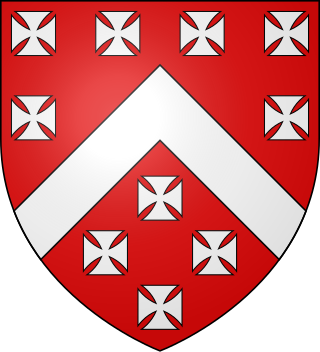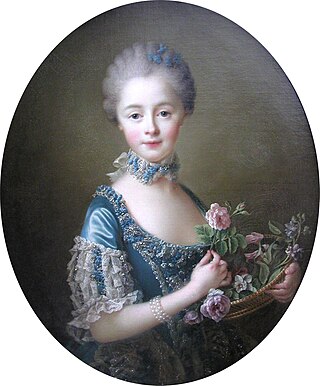Related Research Articles

Baron de Ros of Helmsley is the premier baron in the Peerage of England, created in 1288/89 for William de Ros, with precedence to 24 December 1264. Premier baron is a designation and status awarded to the holder of the most ancient extant barony of the Peerage of England. Before the Dissolution of the Monasteries the Prior of the Order of St John in England was deemed the premier baron.

Baron Hastings is a title that has been created three times. The first creation was in the Peerage of England in 1290, and is extant. The second creation was in the Peerage of England in 1299, and became extinct on the death of the first holder in c. 1314. The third creation was in the Peerage of England in 1461, and has been in abeyance since 1960.

Baron FitzWalter is an ancient title in the Peerage of England. It was created on 24 June 1295 for Robert FitzWalter. The title was created by writ, which means that it can descend through both male and female lines.

Baron Willoughby de Eresby is a title in the Peerage of England. It was created in 1313 for Robert de Willoughby. Since 1983, the title has been held by Jane Heathcote-Drummond-Willoughby, 28th Baroness Willoughby de Eresby.

Baron Wharton is a title in the Peerage of England, originally granted by letters patent to the heirs male of the 1st Baron, which was forfeited in 1729 when the last male-line heir was declared an outlaw. The Barony was erroneously revived in 1916 by writ of summons, thanks to an 1844 decision in the House of Lords based on absence of documentation. As such, the current Barony of Wharton could more accurately be listed as a new Barony, created in 1916, with the precedence of the older Barony.

Baron Berners is a barony created by writ in the Peerage of England.

The title Baron Berkeley originated as a feudal title and was subsequently created twice in the Peerage of England by writ. It was first granted by writ to Thomas de Berkeley, 1st Baron Berkeley (1245–1321), 6th feudal Baron Berkeley, in 1295, but the title of that creation became extinct at the death of his great-great-grandson, the fifth Baron by writ, when no male heirs to the barony by writ remained, although the feudal barony continued. The next creation by writ was in 1421, for the last baron's nephew and heir James Berkeley. His son and successor William was created Viscount Berkeley in 1481, Earl of Nottingham in 1483, and Marquess of Berkeley in 1488. He had no surviving male issue, so the Marquessate and his other non-inherited titles became extinct on his death in 1491, whilst the barony passed de jure to his younger brother Maurice. However, William had disinherited Maurice because he considered him to have brought shame on the noble House of Berkeley by marrying beneath his status to Isabel, daughter of Philip Mead of Wraxhall, an Alderman and Mayor of Bristol. Instead, he bequeathed the castle, lands and lordships comprising the Barony of Berkeley to King Henry VII and his heirs male, failing which to descend to William's own rightful heirs. Thus on the death of King Edward VI in 1553, Henry VII's unmarried grandson, the Berkeley inheritance returned to the family. Therefore, Maurice and his descendants from 1492 to 1553 were de jure barons only, until the return of the title to the senior heir Henry, becoming de facto 7th Baron in 1553. Upon his death he was succeeded by his relative George Harding.
Baron Arlington is a title in the Peerage of England which was created, on 14 March 1665, for Sir Henry Bennet, younger brother of John Bennet, 1st Baron Ossulston. In 1672, he was made Earl of Arlington and Viscount Thetford, and was regranted the title of Baron Arlington, with a special remainder allowing it to pass to both male and female descendants, rather than only heirs male, as was customary with most peerages. Its territorial designation is the birthplace of its first holder Harlington, London, which was also known as Arlington.

Baron Strange is a title which has been created four times in the Peerage of England. Two creations, one in 1295 and another in 1326, had only one holder each, upon whose deaths they became extinct. Two of the creations, that of 1299 and that of 1628, are extant. The surname Le Strange was Latinized as Extraneus. The arms of Le Strange of Knockin Castle in Shropshire were: Gules, two lions passant argent.

Earl of Yarborough is a title in the Peerage of the United Kingdom. It was created in 1837 for Charles Anderson-Pelham, 2nd Baron Yarborough.
Baron Beaumont is an ancient title in the Peerage of England, created in 1309 for a younger branch of the French counts of de Brienne family. The sixth Baron Beaumont was created Viscount Beaumont in 1432; after the death of his son the 2nd Viscount both titles fell into abeyance.
Baron Furnivall is an ancient title in the Peerage of England. It was originally created when Thomas de Furnivall was summoned to the Model Parliament on 24 June 1295 as Lord Furnivall. The barony eventually passed to Thomas Nevill, who had married the first baron's descendant Joan de Furnivall, and he was summoned to parliament in her right. Their daughter, Maud de Neville, married John Talbot, who was also summoned to parliament in her right. He was later created Earl of Shrewsbury. On the death of the seventh earl in 1616, the barony fell into abeyance. The abeyance was terminated naturally in favour of the earl's daughter Alethea Howard in 1651 and passed through her to the Dukes of Norfolk. On the death of the ninth Duke in 1777, the barony again fell into abeyance. In 1913 the abeyance was terminated again in favour of Mary Frances Katherine Petre, daughter of Bernard Petre, 14th Baron Petre. Through her father she was a great-great-great-granddaughter of the ninth Baron Petre and his first wife Anne Howard, niece of the ninth Duke of Norfolk, who became co-heir to the Barony on her uncle's death in 1777. On Lady Furnivall's death in 1968 the barony fell into abeyance for the third time.
Baron Fauconberg is an hereditary title created twice in the Peerage of England.
The title Earl of Holderness also known as Holdernesse existed in the late 11th and early 12th centuries as a feudal lordship and was officially created three times in the Peerage of England namely in 1621, in 1644 as a subsidiary title to that of the then-Duke of Cumberland and in 1682. The official creations lasted 5, 38 and 96 years respectively.
The title Baron Bergavenny was created several times in the Peerage of England and once in the Peerage of Great Britain, all but the first being baronies created by error. Abergavenny is a market town in South East Wales with a castle established by the Norman lord Hamelin de Balun c. 1087.

Baron Conyers is a title in the Peerage of England. It was created on 17 October 1509 for William Conyers, the son-in-law of William Neville, 1st Earl of Kent. The abeyance after the death of the 3rd baron was terminated for the 7th Baron Darcy de Knayth, these baronies were held together until the abeyance of 1888, after which the abeyance of these two baronies were separately terminated. Since 1509, the Barons Conyers had held a part of the "right" to the barony Fauconberg, i.e. the part for which the abeyance was terminated in 1903; and since the termination of the abeyance of the barony Fauconberg, the two baronies, Conyers and Fauconberg, had been held together; from 1948 they were abeyant between the two daughters of the 5th Earl of Yarborough. On the death of the younger daughter in 2012 the abeyance terminated automatically in favour of her elder sister, the 15th holder of the title. Since the death of the latter in 2013, the title is in abeyance once more.

Marcia Amelia Mary Pelham, Countess of Yarborough and 13th Baroness Conyers and 7th Baroness Fauconberg, OBE was a British peer who worked in politics for the Conservative Party.

Violet Ida Eveline Herbert, Countess of Powis and suo jure16th Baroness Darcy de Knayth was a British peeress in her own right.

Amelia Osborne, Marchioness of Carmarthen, 12th Baroness Darcy de Knayth, 9th Baroness Conyers, 5th Countess of Mértola, was a British peer and a Portuguese countess.
Sackville George Lane-Fox, 12th Baron Conyers and de jure 15th Baron Darcy de Knayth was a British peer and soldier.
References
- 1 2 3 4 5 6 Mosley, Charles, ed. (2003). Burke's Peerage, Baronetage & Knighthood (107 ed.). Burke's Peerage & Gentry. pp. 1026–1029. ISBN 0-9711966-2-1.
- ↑ Richardson, Douglas (2011). Magna Carta ancestry: a study in colonial and medieval families (2nd ed.). Salt Lake City, UT.: Douglas Richardson. p. 26. ISBN 9781449966386.
- ↑ Richardson, Douglas (2011). Magna Carta ancestry: a study in colonial and medieval families (2nd ed.). Salt Lake City, UT.: Douglas Richardson. pp. 26–28. ISBN 9781449966386.
Hesilrige, Arthur G. M. (1921). Debrett's Peerage and Titles of courtesy. London: Dean & Son. p. 262.
